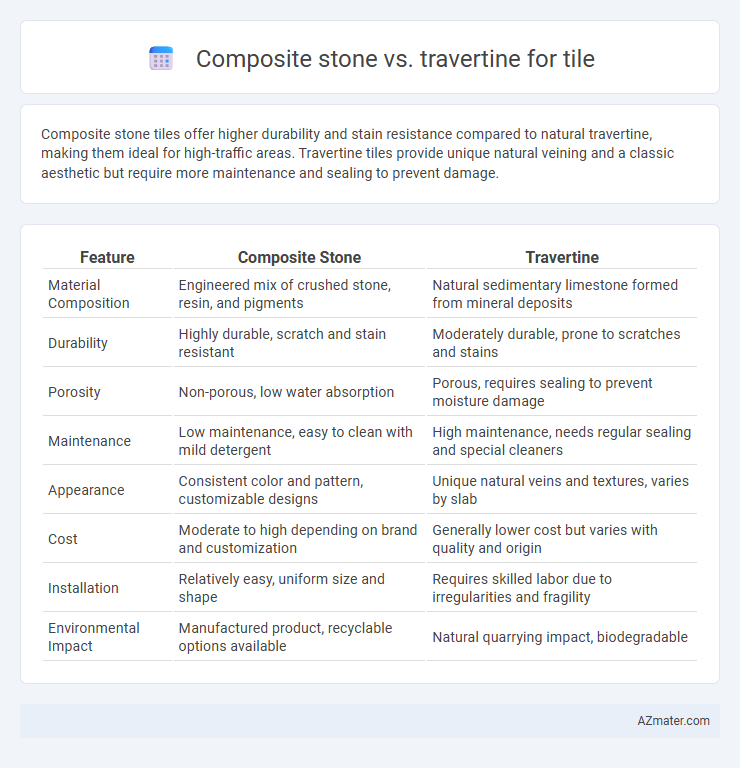Composite stone tiles offer higher durability and stain resistance compared to natural travertine, making them ideal for high-traffic areas. Travertine tiles provide unique natural veining and a classic aesthetic but require more maintenance and sealing to prevent damage.
Table of Comparison
| Feature | Composite Stone | Travertine |
|---|---|---|
| Material Composition | Engineered mix of crushed stone, resin, and pigments | Natural sedimentary limestone formed from mineral deposits |
| Durability | Highly durable, scratch and stain resistant | Moderately durable, prone to scratches and stains |
| Porosity | Non-porous, low water absorption | Porous, requires sealing to prevent moisture damage |
| Maintenance | Low maintenance, easy to clean with mild detergent | High maintenance, needs regular sealing and special cleaners |
| Appearance | Consistent color and pattern, customizable designs | Unique natural veins and textures, varies by slab |
| Cost | Moderate to high depending on brand and customization | Generally lower cost but varies with quality and origin |
| Installation | Relatively easy, uniform size and shape | Requires skilled labor due to irregularities and fragility |
| Environmental Impact | Manufactured product, recyclable options available | Natural quarrying impact, biodegradable |
Introduction to Composite Stone and Travertine
Composite stone tiles, engineered from a blend of natural stone particles and resin binders, offer enhanced durability, uniformity, and resistance to stains and scratches, making them a versatile choice for both indoor and outdoor applications. Travertine, a natural sedimentary limestone formed in mineral springs, is prized for its unique porous texture, warm earthy tones, and classic aesthetic appeal, often requiring sealing to protect against moisture and stains. While composite stone provides consistent patterns and low maintenance, travertine delivers natural beauty and historical charm, influencing the selection based on design preferences and functional requirements.
Composition and Formation Differences
Composite stone tiles consist of engineered materials combining natural stone fragments with resin and pigments, offering enhanced durability and uniformity in appearance. Travertine is a natural sedimentary rock formed through the precipitation of calcium carbonate in mineral-rich hot springs, resulting in its characteristic porous texture and unique veining. The synthetic composition of composite stone provides greater resistance to stains and moisture compared to the naturally porous structure of travertine, which often requires sealing for protection.
Aesthetic Appeal and Color Variations
Composite stone tiles offer a modern aesthetic with consistent coloration and sleek finishes, providing design flexibility for contemporary interiors. Travertine tiles display natural earth-tone hues and distinctive veining patterns, enhancing rustic and Mediterranean styles with unique, organic textures. Color variations in composite stone tend to be uniform and controlled, while travertine presents more irregular, dynamic shades ranging from beige to deep amber.
Durability and Lifespan Comparison
Composite stone tiles, made from engineered materials such as quartz and resin, offer superior durability and a longer lifespan compared to natural travertine tiles. Travertine, a porous limestone, is prone to scratching, chipping, and erosion over time, requiring regular sealing and maintenance to preserve its appearance. Composite stone tiles are highly resistant to stains, cracks, and moisture damage, making them ideal for high-traffic areas and long-term use with minimal upkeep.
Maintenance and Cleaning Requirements
Composite stone tiles require minimal maintenance, featuring high resistance to stains, scratches, and moisture, which makes cleaning straightforward with mild soap and water. Travertine tiles demand more careful upkeep due to their porous nature, requiring regular sealing to prevent stains and damage from acidic cleaners. For long-term durability and ease of maintenance, composite stone is generally preferred over travertine in high-traffic or moisture-prone areas.
Cost Analysis: Composite Stone vs Travertine
Composite stone tiles typically cost between $5 and $15 per square foot, offering affordability and durability due to their engineered composition. Travertine tiles generally range from $8 to $30 per square foot, reflecting higher natural stone value and unique aesthetic appeal but with increased maintenance expenses. Cost analysis favors composite stone for budget-conscious projects, while travertine suits premium installations despite higher initial and upkeep costs.
Installation Process and Versatility
Composite stone offers a streamlined installation process due to its uniform thickness and pre-finished surfaces, which reduces the need for extensive cutting and sealing compared to travertine tiles. Travertine requires more meticulous handling, including sealing and honed or polished finish options, to prevent staining and accommodate its natural porousness. Composite stone provides greater versatility for various indoor and outdoor applications, while travertine's natural texture and color variations make it ideal for luxurious, classic interior designs.
Environmental Impact and Sustainability
Composite stone tiles offer enhanced sustainability by utilizing recycled materials and requiring less energy-intensive manufacturing processes compared to natural travertine. Travertine extraction often leads to habitat disruption and high carbon emissions due to quarrying activities, making it less environmentally friendly. Choosing composite stone supports reduced resource depletion and lower ecological footprints, aligning with greener building practices.
Best Applications for Each Material
Composite stone offers superior durability and resistance to stains, making it ideal for high-traffic areas such as kitchens and commercial spaces where longevity and low maintenance are crucial. Travertine, with its natural porous texture and warm earth tones, excels in decorative applications like bathroom floors, backsplashes, and outdoor patios that benefit from its aesthetic appeal and slip resistance. Selecting composite stone suits modern interiors requiring sleek, uniform surfaces, while travertine complements traditional or rustic designs demanding natural variation and character.
Final Verdict: Choosing the Right Tile for Your Space
Composite stone tiles offer superior durability, low maintenance, and a wide range of customizable colors and patterns, making them ideal for high-traffic areas and modern designs. Travertine provides a natural, elegant appearance with unique veining and a warm color palette that enhances traditional or rustic interiors but requires regular sealing to prevent stains and wear. For spaces demanding longevity and versatility, composite stone is the optimal choice, while travertine suits environments where aesthetic appeal and natural texture are priorities.

Infographic: Composite stone vs Travertine for Tile
 azmater.com
azmater.com